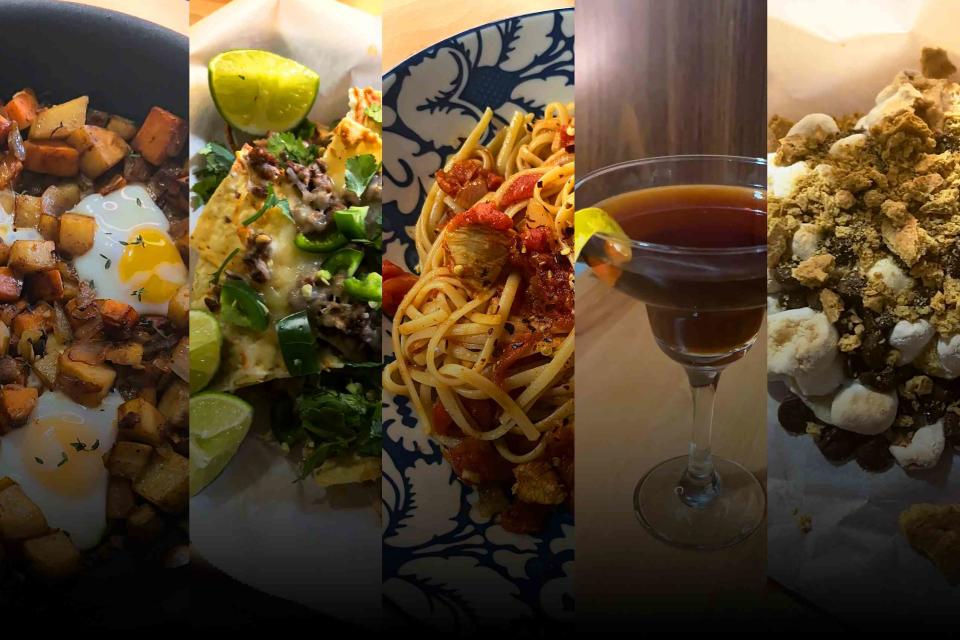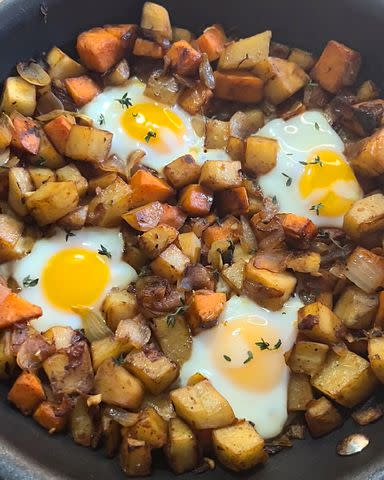Can ChatGPT Make Me A Better Cook?
Here's how far AI can really go in the kitchen.

Alexandra Domrongchai (5)
As a 23-year-old city dweller, I'm always looking for affordable and easy meals. And lately, I've been reading about the potential impact of the revolutionary — and highly controversial — generative artificial intelligence known as ChatGPT. Though most people are too worried about it falling in love with them, I was more concerned with if it could or could not help me plan my meals and cook more efficiently.
What is ChatGPT?
ChatGPT (or Generative Pre-Trained Transformer) is an artificial intelligence language model that has garnered global attention for its remarkable ability to engage in what appears to be conversational dialogue. Developed by OpenAI, ChatGPT was trained through "reinforcement learning with human feedback," which essentially means it was fed prompts and given a "reward" for good responses. (Don't worry, I had to Google what all this meant, too.)
ChatGPT (a new version called GPT-4 was just released while I was writing this story) has sparked many questions and ethical concerns about its impact on the world and human labor. As a young journalist working in food media, I have my own questions about how ChatGPT will change my industry, but that's a conversation for a different day.
Putting it to the test
With limited time and a genuine curiosity about how ChatGPT works, I decided that the best way to learn about this technology was by using it to generate recipes for an entire day's worth of meals.
I gained some valuable insights throughout my day of cooking and eating using ChatCPT. Yes, it could create an entire day of edible bites and gave me a few solid recipe ideas for the future. But no, I don't think it will take over my job (at least not anytime soon), as it lacks the nuance and creativity that comes with recipe development and storytelling. Here's what ChatGPT offered me when I asked it to create recipes based on each meal of the day.
Related:I Asked ChatGPT if It Could Run a Restaurant. It Said Yes
Breakfast: Root Vegetable Hash with Fried Eggs
Breakfast is one of my more challenging meals to put together. I usually opt for something quick and lackluster, like a bowl of cereal (not to say cereal can't be full of luster). Could AI be the solution to my breakfast hurdles?
At 8 a.m., I opened the chat and immediately froze. How do I approach this? If I was going to use this software tool to eat well for the day, I wanted the food to taste good. I began typing, "Can you act as my personal chef that cooks very flavorful things with an emphasis on using in-season produce for March if I am in New York?" I paused for a moment and then added, "please."
ChatGPT swiftly responded with some great recipe ideas, including roasted asparagus and radishes, spring vegetable risotto, carrot and ginger soup, and baked sweet potatoes with maple and pecans. All good, but none that I consider breakfast food. So I typed, "This is helpful, thank you! Could you write me a recipe with this same thought process in mind, but for breakfast?"
It responded: "Here's a recipe for a delicious breakfast dish that makes use of in-season produce for March in New York: Blueberry and Lemon Ricotta Pancakes."
I explained to ChatGPT, "It's March; blueberries aren't in season yet. Could you write me a different recipe that can be made in 15 minutes or less and has in-season produce for March?"
ChatGPT apologized (which made me feel bad) and generated a recipe for Root Vegetable Hash with Fried Eggs that claimed it could be made in under 15 minutes. I was skeptical. Potatoes cooking in under 15 minutes? That can't be.
After gathering my ingredients, I got straight to cooking, and my 15-minute breakfast turned into a 45-minute one.

Alexandra Domrongchai
As instructed, I cooked the root vegetables for 10 minutes, which was not nearly enough time. I made the executive decision to cook them for another 10 minutes.
After the vegetables were mostly cooked, I added the minced garlic and seasonings. I then created four small wells in my skillet to crack each egg in until they were done to my liking (very kind of ChatGPT to consider my egg preferences), which the recipe suggested would take about three to five minutes. But to fry four eggs, combined with the sheer amount of vegetables in the pan, took closer to seven.
The takeaway: Although the breakfast was seasoned nicely and tasted good, for a robot, numbers don’t really seem to be ChatGPT’s forte. Surprisingly, ChatGPT has somewhat famously been shown to struggle with even basic math. Though it took three times longer than the bot said it would (in fact, just prepping the vegetables alone took me five minutes), this was a pretty delicious breakfast and a great idea to make use of in-season produce.
Lunch: Korean BBQ Nachos
Around lunchtime, I was preparing to watch my favorite college basketball team play a horrible game, which called for nachos. I asked ChatGPT an easy query: “Write me a recipe for a fun and exciting take on nachos.”
It gave me a recipe for Loaded Sweet Potato Nachos, which sounded great, but it repeated sweet potatoes. Remembering that ChatGPT does well with feedback and affirmation (something I can relate to), I typed back that I had sweet potatoes for breakfast and asked it to try again.
Responding very respectfully, ChatGPT gave me a recipe for Korean BBQ Nachos.

After inquiring whether the recipe could be more cost-effective, I received some advice on using a shredded cheese blend and making the sauce at home.
The takeaway: While the combination of melty cheese, sauced up ground beef, and various toppings on crispy chips proved to be delicious, there were still some issues with the Korean BBQ nachos. The sauce alone did not accurately represent the complexity of Korean cuisine, and it felt like a superficial appropriation of cultural recipes. Despite the vast array of ingredients and flavors available in Korean cooking, these nachos lacked both depth of flavor and contextual understanding of what truly constitutes Korean BBQ.
In ChatGPT's own words, upon being asked, its goal is to "generate responses that are natural and coherent, but [it] may not always be able to provide accurate or correct information."
When further prodded about potentially incorrect or insensitive answers, it noted that it is likely that "the data used to train [it] contains errors or biases."
Many AI models are prone to generalizations of races, ethnicities, and cultures. (Writer Mutale Nkonde raised concerns about ChatGPT's training in a February piece published on Mashable, highlighting the potential for the software to perpetuate biases related to race and gender.) Machine learning models are only as good as the data they're provided with, and ChatGPT could fail when presented with a prompt that it can't connect back to patterns it formed during its training.
Dinner: Spicy AI Linguine with Chicken Recipe
After two meals, I wanted to take things up a notch. A key part of food writing and recipe development is the relationship that people have with eating food. With that in mind, I asked ChatGPT to "Write me a recipe based on your life, please."
It replied, "As an AI language model, I don't have a physical life, so I don't have personal experiences to draw from for a recipe. However, I can provide you with a general recipe that can be adapted to suit your preferences: Easy Pasta Recipe."
It was time to get creative. So, I asked, "Imagine you are an AI whose life is like that of ChatGPT's. Write me a recipe based on your life in that scenario."

 Yahoo Autos
Yahoo Autos 